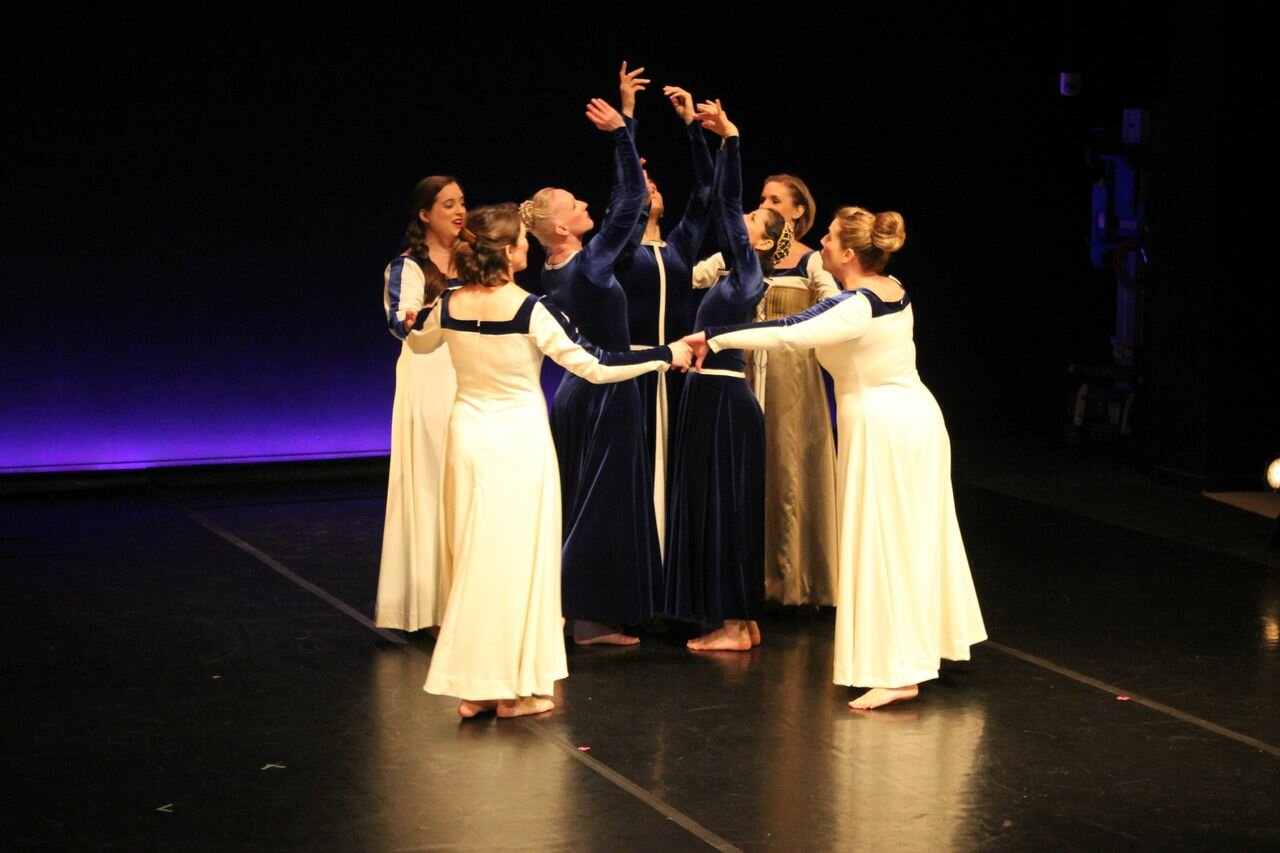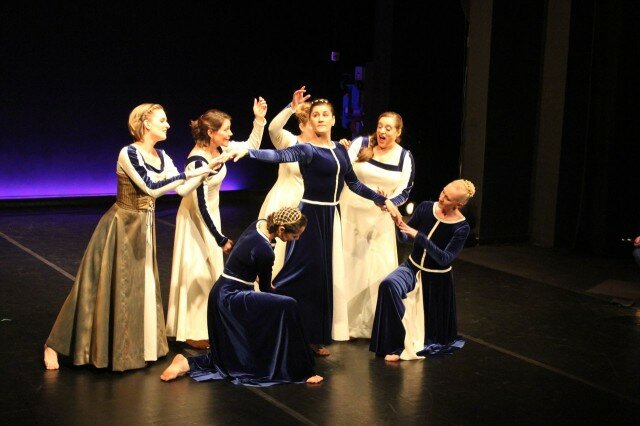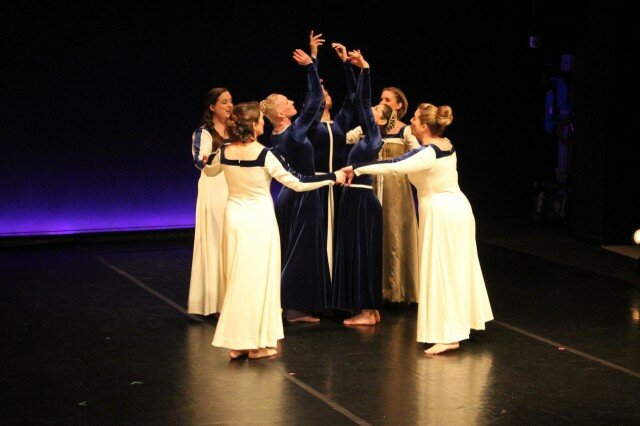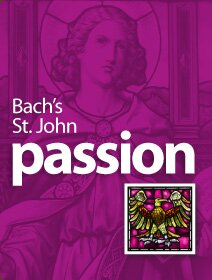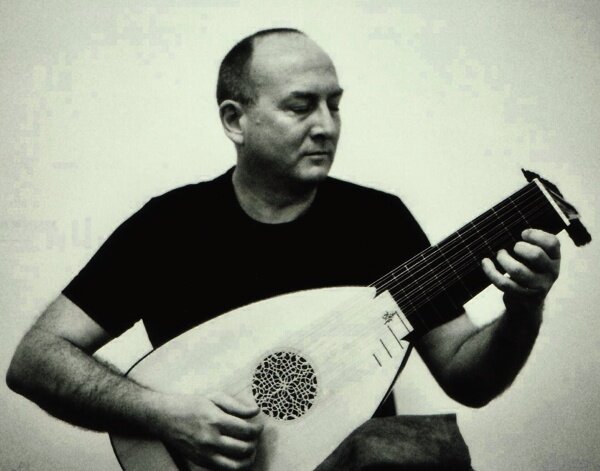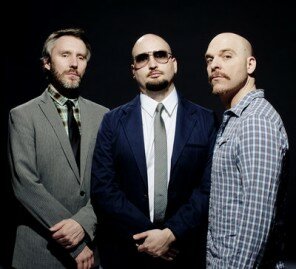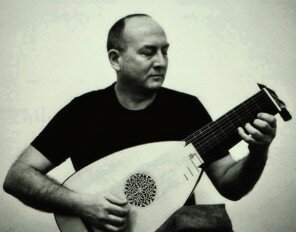Pacific MusicWorks’ program titled Wayward Sisters has been four years incubating, but the result Friday night was well worth the wait.
The concert included four sopranos, three dancers and three musicians, but the strands gathered to present the performance ratcheted up this year’s noticeable trend in presenting companies: collaboration.
Performing 17th and late-16th century songs for one, two, or three sopranos, the singers joined three dancers in movement choreographed by Anna Mansbridge to illustrate the words. The small black box-style stage at Langston Hughes Performing Arts Center, lit by Connie Yun, perfectly set off their costumes by Christine Smith, inspired by a 1394 painting.
Over a cream-colored long-sleeved underdress, square-necked and bordered in dark brown, each singer wore a straight, waisted, light-brown overdress with a laced bodice. The dancers wore a deep blue velvet overdress, long sleeved and very plain, over a cream-colored shift with simple pearl decorations in their hair.
Stephen Stubbs, artistic director of PacificMusicWorks, and Mansbridge, artistic director of Seattle Early Dance, had been working together in workshops, the former teaching Baroque and Renaissance vocal performance while Mansbridge choreographed their movements. Deciding to do such a collaboration with professional singers and dancers led, in Stubbs’ words, to “a very exciting encounter between 17th century music and modern performance.”
Pacific MusicWorks spearheaded and presented Wayward Sisters with Mansbridge, dancers from Seattle Dance Project (co-founded five years ago by Pacific Northwest Ballet retiree Timothy Lynch), composer Karen P. Thomas of Seattle Pro Musica, costume designer Smith (last seen working on the Roméo et Juliette costumes for PNB), and lighting designer Yun (often in the lighting credits for Seattle Opera).
The 270-seat theater, which is steeply raked with excellent sightlines and equally excellent acoustics, turned out to be a fine choice of venue.
The germ for the project came from 16th-century Italy, where for the first time a trio of sopranos performed in private for the Este court, while a similar trio later entertained at a splendiferous Medici wedding in 1589, and a mother-daughters trio several decades later in Mantua.
The sopranos, Shannon Mercer, Teresa Wakim, Erin Calata, and Catherine Webster were joined by a side-stage singer, Julianna Emanski, who at the last moment came in to sing for Webster who had laryngitis. Webster was able, however, to be on stage moving with her colleagues, lip-synching, so that it was easy to forget someone else was singing for her. Kudos to Emanski for her good work.
The music was glorious. From the Medici wedding came the “Ballo del gran duca” by Cavalieri, performed by all the singers who joined with the dancers who wove around and between them, swirling with flowing arms. Ensuing pieces, by Domenico and Virgilio Mazzochi, Luigi Rossi, Monteverdi’s great “Lamento d’Arianna,” and a scene from Rossi’s Orfeo for Euridice, alternated with dance alone, or with instrumental works.
All the singers, trained in Renaissance and Baroque style, sang with rich, expressive voices but without vibrato. Their pitch sense was extraordinary. There is nowhere to hide when singing this way, and intervals were pure, harmonies and lines exquisite. As for emotion, both vocal and physical, though the lights were down in the audience it was easy to ascertain what was being expressed, from joy to despair, bereavement and grief, even at one point an expression of being ready to kill, so furious was the protagonist.
The dancers, Elizabeth Cooper, Alexandra Dickson, and Ellie Sandstrom, brought finely trained bodies to the choreography, which was more timeless in style than with any particular connection to the dates of the songs, but which brought their meaning to a visual realization. It was fluid, yearning, graceful, sad or sprightly, and at one point one could see some yoga-derived moves.
Stubbs, playing lute or guitar, Maxine Eilander, harp, and David Morris playing bass viola da gamba or lirone (a similar instrument, fretted and with about 13 strings and two drone strings), accompanied the singers and dancers with superb performances of the several songs and dances as well as a couple of solos.
By no means least in this embarrassmant of artistic riches came a new work composed by Karen P. Thomas for Pacific MusicWorks for this configuration of singers and instruments. She set a poem by 17th-century English metaphysical poet Andrew Marvell, “Dialogue between the Soul and the Body,” each complaining of the limitations the other places on it.
Thomas made the most of it, including many word paintings, such as a sudden drop on the last syllable of “precipice,” a bunch of shudders on “shake,” and twice the speed on repetitions of “double.” You can imagine what she did with “cramp.” As always with Thomas, this was composed and executed with imagination, skill, and musical interest.
There was only the one performance of Wayward Sisters planned, but it’s to be hoped the program will be repeated some time. It’s far too good, too polished and seamless a production, too fascinating with so much to take in and enjoy, to be allowed to die now.
